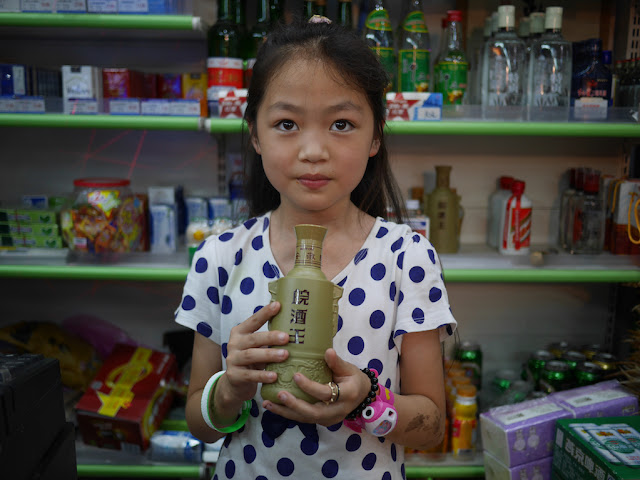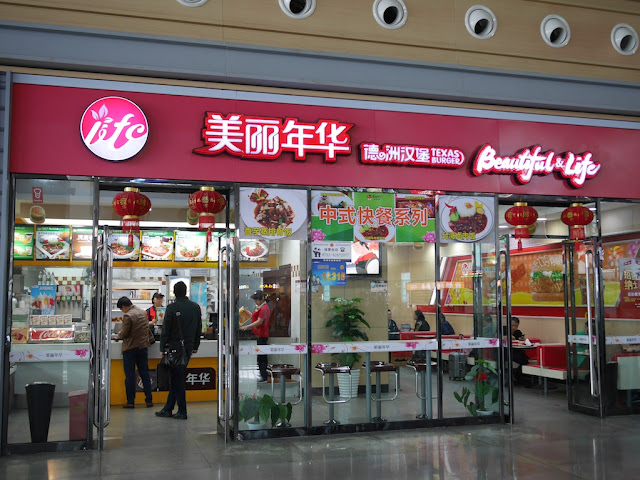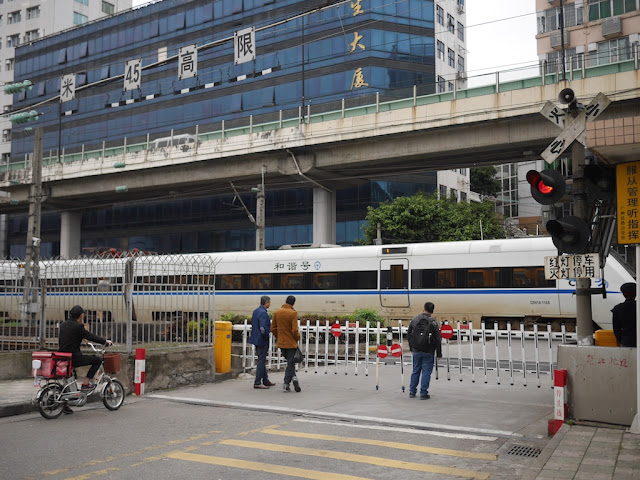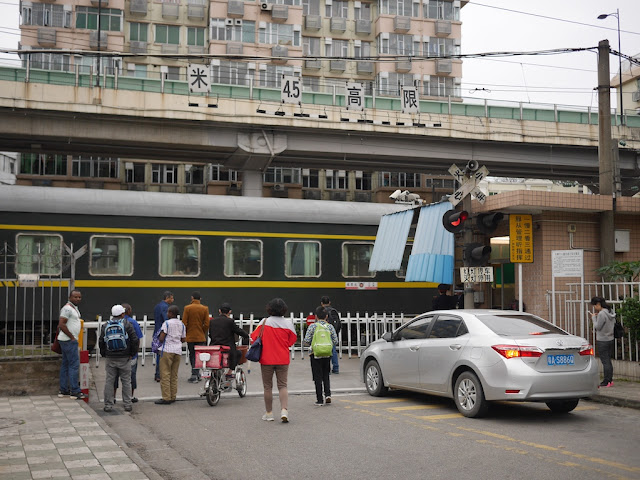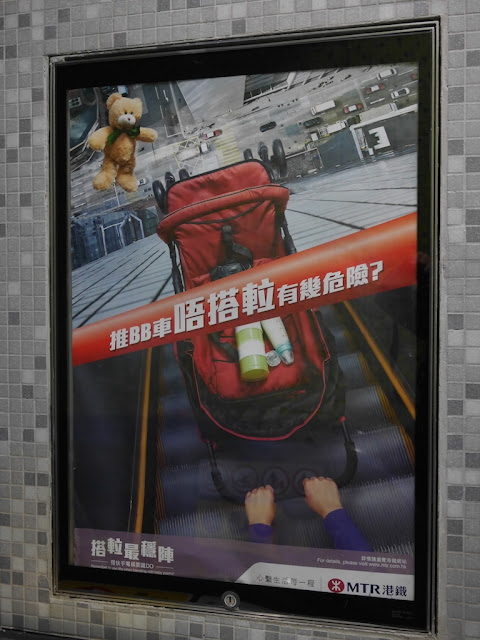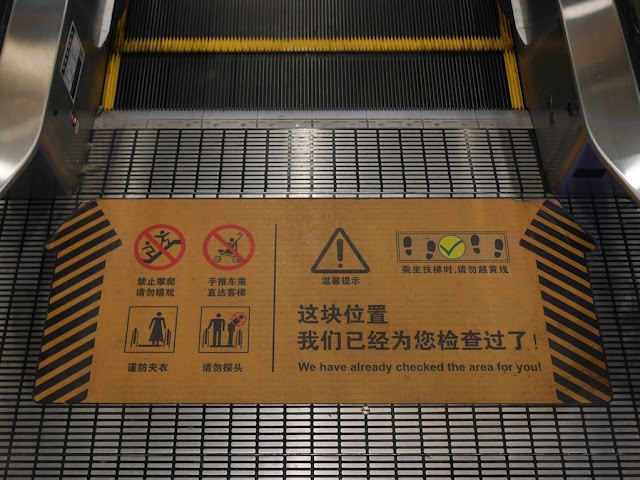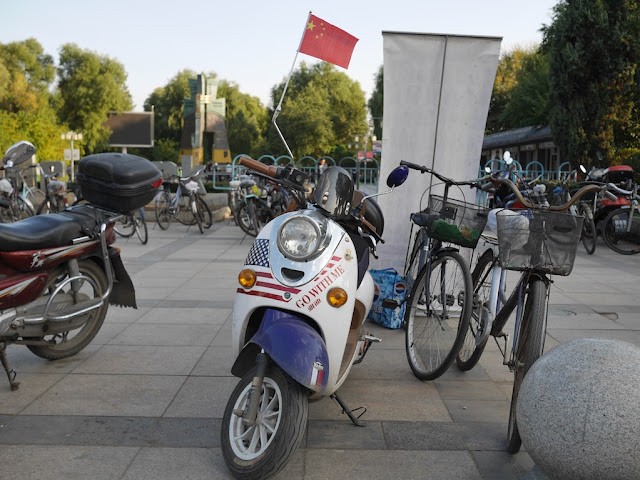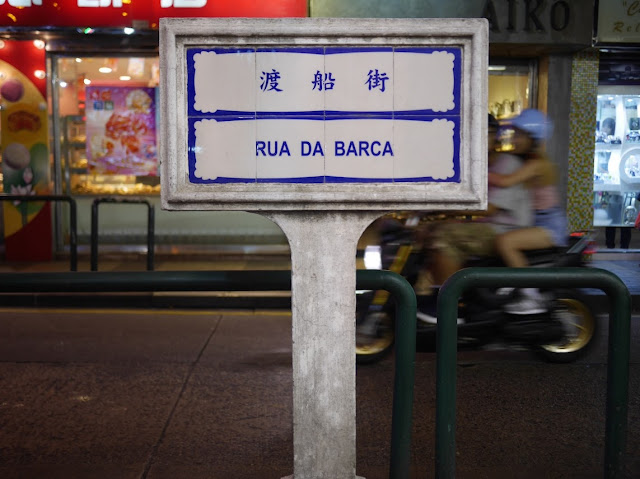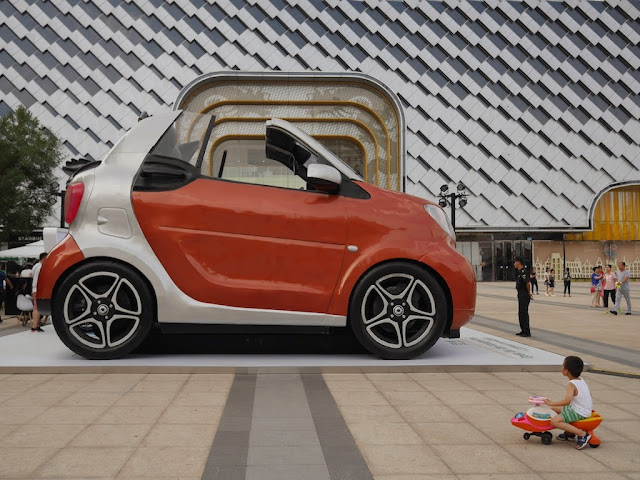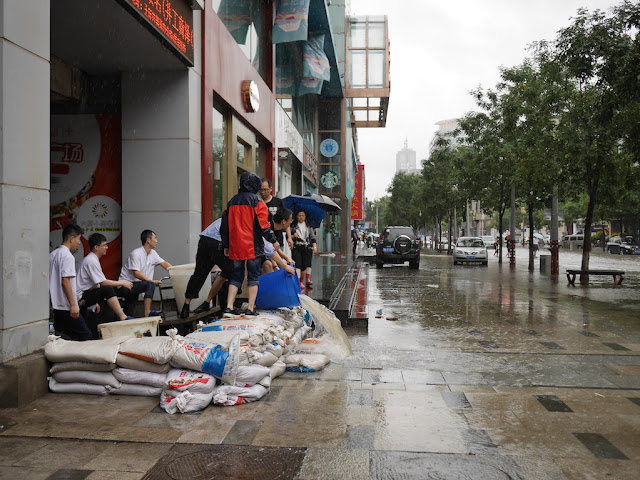Showing posts with label Transportation. Show all posts
Showing posts with label Transportation. Show all posts
Tuesday, August 15, 2017
Tuesday, August 1, 2017
Monday, July 31, 2017
Thursday, July 6, 2017
A Bit of Bengbu on the Fourth of July
Posted by
Brian Glucroft
at
9:52 PM
Two days ago in Bengbu, a city in China's Anhui province, I spent the evening trying to celebrate the Fourth of July. Like a big part of my reasoning for choosing to visit Bengbu — appreciating the sound of its name — I saw it as a way to mix things up and learn things I may not have otherwise learned about China. I don't have as much of a story to tell about the night as I did a few years ago for a Fourth of July in Hengyang, Hunan. And while I did find much of interest, it would make more sense to share most of it in other contexts. Still, I have a bit of story . . .
The night started more fittingly than I could have ever reasonably expected. Seconds after heading out, I saw a Stars & Stripes themed motor scooter driving off.
While I have seen scooters with an American flag design in China on occasion before, including one other in Bengbu, the timing here was wonderful. This really happened.
Later in the evening, I saw a scooter with a design seemingly inspired by a country who played a large role in making the Fourth of July happen.
I see these British-looking designs on motor scooter far more often, so this was less of surprise.
After several nighttime snacks including two local items and one Big Mac, I stopped by a small convenience store to buy a celebratory drink. A Bengbu brand of baijiu struck me as a grand idea, and I jokingly asked a young girl who was eager to help whether she liked it or not. With body language playfully suggesting she wasn't exactly telling the truth, she said she did. Her mother (I presume) and I laughed. Good enough.
So for 15 yuan (about U.S. $2.20) I bought a bottle of Bengbu Baijiu — not its name based on the Chinese (皖酒王), which more emphasizes its Anhui roots, but I like how it rolls of the tongue.
During a discussion with the taxi driver as I headed back to my hotel, I wasn't surprised to learn she didn't know July 4 had any significance in the U.S. But I was a bit surprised when she said she liked drinking this brand of baijiu. And I gotta say, as far a cheap baijiu goes I found it to be pretty decent. I didn't finish it though. I had more explorations planned for the Fifth of July.
The night started more fittingly than I could have ever reasonably expected. Seconds after heading out, I saw a Stars & Stripes themed motor scooter driving off.
Later in the evening, I saw a scooter with a design seemingly inspired by a country who played a large role in making the Fourth of July happen.
I see these British-looking designs on motor scooter far more often, so this was less of surprise.
After several nighttime snacks including two local items and one Big Mac, I stopped by a small convenience store to buy a celebratory drink. A Bengbu brand of baijiu struck me as a grand idea, and I jokingly asked a young girl who was eager to help whether she liked it or not. With body language playfully suggesting she wasn't exactly telling the truth, she said she did. Her mother (I presume) and I laughed. Good enough.
So for 15 yuan (about U.S. $2.20) I bought a bottle of Bengbu Baijiu — not its name based on the Chinese (皖酒王), which more emphasizes its Anhui roots, but I like how it rolls of the tongue.
During a discussion with the taxi driver as I headed back to my hotel, I wasn't surprised to learn she didn't know July 4 had any significance in the U.S. But I was a bit surprised when she said she liked drinking this brand of baijiu. And I gotta say, as far a cheap baijiu goes I found it to be pretty decent. I didn't finish it though. I had more explorations planned for the Fifth of July.
Thursday, June 1, 2017
Baidu Map, a Banana, and Baijiu: From Guiyang to Changsha
Posted by
Brian Glucroft
at
1:38 AM
Not so long ago in Guiyang, I woke up early one morning and caught a taxi. At the first intersection, the driver took an unexpected turn. Based on the traffic signals, it seemed plausible it was a wise choice, and I said nothing. A couple of blocks later, he signaled to make a turn heading in a direction nearly opposite of where I was headed. It didn't seem likely this choice was in my best interest, so I asked why he wasn't turning a different direction on another road. After some back and forth, I mentioned I had checked the routes on Baidu Map. The best option was rather clear and the most reasonable alternatives didn't involve what he had in mind.
He said "Oh, you checked Baidu Map. Then we will go that way."
It worked out pretty well.
Once I was inside the departure hall of the Guiyang North Railway Station, I wasn't surprised by the small crowd. I was catching an early morning train at 6:52 a.m. after all.
But I found it notable that the retail space on the upper levels on two sides of the departure hall, a design common in China's larger new railway stations, appeared to be completely vacant and lacking any restaurants or cafes. There wasn't even a Texas Burger. It reminded me of a similar pattern I saw five years ago at the Shenzhen North Railway Station — a place that is more occupied and busier now.
Soon I was on the high-speed train, which departed on schedule. Like my previous two trips, I was traveling a route for the first time. This route spent less time in tunnels than my previous trip though. And the train traveled at a much higher speed (about 300 km/h) than on the previous two routes (which maxed out at about 200 km/h).
A college student sitting next to me on the train kindly offered a welcomed banana, providing some balance to having had a mangosteen stolen in Guiyang. After discovering I liked spicy foods, she then gave me two small packages of spicy treats. One of them was especially tasty, and I was confident I was not going to go short on my salt intake for the day.
When I later mentioned I was catching a flight out of the Changsha the very next day, she asked whether I couldn't have flown out of Guiyang instead. Indeed, I would have done that had I better predicted things when I purchased the ticket. My schedule during the past month or so hadn't gone exactly as first planned. I spent more time than expected in Hengyang, which meant I had to skip Yongzhou. I then spent more time than expected in Guilin, which meant I had to skip Liuzhou and some other potential locations. I had just spent more time than expected in Guiyang, which meant I had to skip Kaili and Huaihua. In short, I wasn't arriving in Changsha a few days before my flight from a closer city as I had first expected. All of this reflects a tension between spending more time in individual cities versus visiting more cities. Both have their merits.
So after a three hour and twenty-something minute train ride, I had about 24 hours in Changsha. I initially thought I would put together a "day in Changsha" post similar to the one when I was last in Changsha, which also involved a one day stay followed by a flight. But that visit had occurred less than half a year after an earlier visit to Changsha, when I spent much more time there. A quick catchup here made sense. But this visit involved a one and half year gap from the previous one day visit and a nearly two year gap since my last extended stay. Not only was there much more which had changed, I more effectively maxed out my time. By the end of the day I wasn't just exhausted, I felt like all of what I had found deserved more than being put together in a single post.
So instead of a new "day in Changsha" post, for now I will share a single scene from Huangxing Square in Changsha which reminded me of scenes I have shared from Guangzhou and from Shenyang.
Yes, on the digital billboard is yet another blissfully blue baijiu advertisement from Yanghe Distillery. But instead of featuring their Tianzhilan baijiu, it features their Mengzhilan M6. which according to Yanghe:
Anyway, more soon. I will be in less of a exploratory mode during the next few weeks, so I hope to get slightly caught up on some things. Just need to decide what is next. Perhaps more about Changsha. Perhaps where I headed after Changsha. Perhaps where I was before. Perhaps some other new historical period.
He said "Oh, you checked Baidu Map. Then we will go that way."
It worked out pretty well.
Once I was inside the departure hall of the Guiyang North Railway Station, I wasn't surprised by the small crowd. I was catching an early morning train at 6:52 a.m. after all.
But I found it notable that the retail space on the upper levels on two sides of the departure hall, a design common in China's larger new railway stations, appeared to be completely vacant and lacking any restaurants or cafes. There wasn't even a Texas Burger. It reminded me of a similar pattern I saw five years ago at the Shenzhen North Railway Station — a place that is more occupied and busier now.
Soon I was on the high-speed train, which departed on schedule. Like my previous two trips, I was traveling a route for the first time. This route spent less time in tunnels than my previous trip though. And the train traveled at a much higher speed (about 300 km/h) than on the previous two routes (which maxed out at about 200 km/h).
A college student sitting next to me on the train kindly offered a welcomed banana, providing some balance to having had a mangosteen stolen in Guiyang. After discovering I liked spicy foods, she then gave me two small packages of spicy treats. One of them was especially tasty, and I was confident I was not going to go short on my salt intake for the day.
When I later mentioned I was catching a flight out of the Changsha the very next day, she asked whether I couldn't have flown out of Guiyang instead. Indeed, I would have done that had I better predicted things when I purchased the ticket. My schedule during the past month or so hadn't gone exactly as first planned. I spent more time than expected in Hengyang, which meant I had to skip Yongzhou. I then spent more time than expected in Guilin, which meant I had to skip Liuzhou and some other potential locations. I had just spent more time than expected in Guiyang, which meant I had to skip Kaili and Huaihua. In short, I wasn't arriving in Changsha a few days before my flight from a closer city as I had first expected. All of this reflects a tension between spending more time in individual cities versus visiting more cities. Both have their merits.
So after a three hour and twenty-something minute train ride, I had about 24 hours in Changsha. I initially thought I would put together a "day in Changsha" post similar to the one when I was last in Changsha, which also involved a one day stay followed by a flight. But that visit had occurred less than half a year after an earlier visit to Changsha, when I spent much more time there. A quick catchup here made sense. But this visit involved a one and half year gap from the previous one day visit and a nearly two year gap since my last extended stay. Not only was there much more which had changed, I more effectively maxed out my time. By the end of the day I wasn't just exhausted, I felt like all of what I had found deserved more than being put together in a single post.
So instead of a new "day in Changsha" post, for now I will share a single scene from Huangxing Square in Changsha which reminded me of scenes I have shared from Guangzhou and from Shenyang.
Yes, on the digital billboard is yet another blissfully blue baijiu advertisement from Yanghe Distillery. But instead of featuring their Tianzhilan baijiu, it features their Mengzhilan M6. which according to Yanghe:
. . . inherits the element of the ancient Yanghe Liquor, and transforms itself gracefully in the new historical period by perfectly interpreting the definition of the treasured Liquor with pure and exquisite technology.How about that?
Anyway, more soon. I will be in less of a exploratory mode during the next few weeks, so I hope to get slightly caught up on some things. Just need to decide what is next. Perhaps more about Changsha. Perhaps where I headed after Changsha. Perhaps where I was before. Perhaps some other new historical period.
Tuesday, May 9, 2017
A Fast Trip of Many Tunnels: From Guilin to Guiyang
Posted by
Brian Glucroft
at
11:24 PM
Yesterday morning in Guilin I caught a taxi. It was rush hour, but at least I was headed out of the city center. Upon arrival at the Guilin North Railway station, I figured since it wasn't raining very hard I would get out of the taxi before opening my umbrella. I then found out the taxi had stopped at a place where a steady stream of water was pouring from a roof perfectly positioned for not covering a reasonable area where people might get out of a car.
My back was quickly drenched.
Life went on, and soon I was in the station. I didn't see a Texas Burger restaurant, but I had no need for one. I had recently eaten a small pack of unsalted roasted pumpkin seeds. Really, unsalted roasted pumpkin seeds are both good and filling.
Like my previous intercity trip, I boarded a high-speed train taking a route I had never traveled before. I expected many beautiful scenes. When some sunlight could penetrate to the tracks, even through clouds, some beautiful scenes did indeed appear. But these sunlit moments were fewer than I had expected. From the first stop in Rongjiang to my destination, I conservatively estimated at least 70% of the journey occurred while in tunnels. I have been on other rail lines with many tunnels, but this one was in a league of its own.
There are a lot of mountains in this part of China. And the high-speed rail line just goes straight through them. Fantastic for saving time. Not so great for views. Quite impressive though.
Upon arrival at my destination's North Railway Station, I quickly realized it was much larger than Guilin's. I also discovered that the taxi line is far past the still-under-construction subway station and past a long series of bus stops. But I still felt strength being drawn from the pumpkin seeds, so all was fine.
And soon I enjoyed a view from high up in the city.
No guessing games this time. If you can't identify the city from the photo (I suspect few can) or the title of this post (I suspect many can), I am now in Guiyang — the capital of Guizhou.
My first and only previous time in Guilin was nine years ago. My first time in Guiyang was eight years ago, and I last returned six years ago. In both cities a lot has changed, and that is part of the reason I haven't posted as much as I would have liked. There has been a lot to discover, sort out, and digest. Plenty of material for the future though . . .
And fear not, soon after my arrival in Guiyang I was enjoying an excellent sour and spicy dish. Pumpkin seeds have their limits.
My back was quickly drenched.
Life went on, and soon I was in the station. I didn't see a Texas Burger restaurant, but I had no need for one. I had recently eaten a small pack of unsalted roasted pumpkin seeds. Really, unsalted roasted pumpkin seeds are both good and filling.
Like my previous intercity trip, I boarded a high-speed train taking a route I had never traveled before. I expected many beautiful scenes. When some sunlight could penetrate to the tracks, even through clouds, some beautiful scenes did indeed appear. But these sunlit moments were fewer than I had expected. From the first stop in Rongjiang to my destination, I conservatively estimated at least 70% of the journey occurred while in tunnels. I have been on other rail lines with many tunnels, but this one was in a league of its own.
There are a lot of mountains in this part of China. And the high-speed rail line just goes straight through them. Fantastic for saving time. Not so great for views. Quite impressive though.
Upon arrival at my destination's North Railway Station, I quickly realized it was much larger than Guilin's. I also discovered that the taxi line is far past the still-under-construction subway station and past a long series of bus stops. But I still felt strength being drawn from the pumpkin seeds, so all was fine.
And soon I enjoyed a view from high up in the city.
No guessing games this time. If you can't identify the city from the photo (I suspect few can) or the title of this post (I suspect many can), I am now in Guiyang — the capital of Guizhou.
My first and only previous time in Guilin was nine years ago. My first time in Guiyang was eight years ago, and I last returned six years ago. In both cities a lot has changed, and that is part of the reason I haven't posted as much as I would have liked. There has been a lot to discover, sort out, and digest. Plenty of material for the future though . . .
And fear not, soon after my arrival in Guiyang I was enjoying an excellent sour and spicy dish. Pumpkin seeds have their limits.
Friday, May 5, 2017
Not a Good Air Day in Guilin
Posted by
Brian Glucroft
at
11:50 PM
 |
| Facing westward at the intersection in Guilin where Huancheng South 2nd Rd becomes Huancheng South 3rd Rd |
Unfortunately, the "good air" Guilin enjoyed yesterday is already a thing of the past. Today the air pollution returned to not-so-good levels, though still nowhere near the recent "hazardous" and beyond levels recorded in a number of northern cities such as Beijing. I even witnessed what appeared to be an attempt to improve Guilin's air today. I am skeptical it had much of an effect though. More about that later.
Tuesday, May 2, 2017
From Texas Burger in Hunan to a Scenic High-Speed Train Ride
Posted by
Brian Glucroft
at
8:20 PM
Towards the end of last week I hailed a taxi and told the driver I needed to go to the Hengyang East Railway Station. He asked for 40 yuan (about U.S. $5.80). I felt confident 40 yuan was too high, but I wasn't sure what to target for bargaining. I just told him to use the meter. He clearly didn't like that idea, so I prepared to get out of the taxi.
He turned on the meter.
The fare turned out to be 27 yuan.
I hadn't had time to eat much that day, and I hoped to grab something at the station. I suspected the options were minimal and the McDonald's there would be my best bet despite my fondness for Hengyang's local dishes. But I worried I wouldn't be able to go down to the arrivals level, order food, and then return to the departures level to go through the ID check and security in time for boarding. So I went straight into ticketed-area of the station and hoped to find something there.
Once inside, I saw something I expected — a lack of a McDonald's — and I saw something I hadn't expected — Texas Burger. I hadn't recently seen any of the once common New Orleans roasted chicken vendors in Hengyang. I figured it was now time for some not-quite-Texas fare in Hengyang.
I quickly scanned the menu and didn't see anything named a Texas Burger, so I ordered a burger which looked like a Big Mac. I didn't go for the full meal.
The burger I soon received looked far more compressed than the one displayed in the menu. And the taste . . . well, the patty made me think of an overcooked old high school cafeteria-style burger. It definitely didn't make me think of anything I had ever eaten in Texas. Without a doubt, I would take New Orleans roasted chicken over that any day.
But at least I wasn't hungry anymore. And soon I departed Hengyang on a train route I had never traveled before. This meant I could enjoy some new views and attempt to photograph them through a dirty window while moving at about 200 kilometers per hour.
In about 2 hours and 40 minutes I arrived at my destination 342 kilometers (213 miles) from the station in Hengyang. Not bad for 100 yuan (U.S. $14.50).
My first view of the city from high up included a McDonald's but no Texas Burgers.
The city is more well known than Hengyang and popular with tourists, though, no, the glass pyramid in the photo isn't the entrance to the Louvre. For those familiar with China, this is a relatively easy one to figure out. Guesses welcome. Let me know if you want some Texas Burger as a prize.
He turned on the meter.
The fare turned out to be 27 yuan.
I hadn't had time to eat much that day, and I hoped to grab something at the station. I suspected the options were minimal and the McDonald's there would be my best bet despite my fondness for Hengyang's local dishes. But I worried I wouldn't be able to go down to the arrivals level, order food, and then return to the departures level to go through the ID check and security in time for boarding. So I went straight into ticketed-area of the station and hoped to find something there.
Once inside, I saw something I expected — a lack of a McDonald's — and I saw something I hadn't expected — Texas Burger. I hadn't recently seen any of the once common New Orleans roasted chicken vendors in Hengyang. I figured it was now time for some not-quite-Texas fare in Hengyang.
I quickly scanned the menu and didn't see anything named a Texas Burger, so I ordered a burger which looked like a Big Mac. I didn't go for the full meal.
The burger I soon received looked far more compressed than the one displayed in the menu. And the taste . . . well, the patty made me think of an overcooked old high school cafeteria-style burger. It definitely didn't make me think of anything I had ever eaten in Texas. Without a doubt, I would take New Orleans roasted chicken over that any day.
But at least I wasn't hungry anymore. And soon I departed Hengyang on a train route I had never traveled before. This meant I could enjoy some new views and attempt to photograph them through a dirty window while moving at about 200 kilometers per hour.
In about 2 hours and 40 minutes I arrived at my destination 342 kilometers (213 miles) from the station in Hengyang. Not bad for 100 yuan (U.S. $14.50).
My first view of the city from high up included a McDonald's but no Texas Burgers.
The city is more well known than Hengyang and popular with tourists, though, no, the glass pyramid in the photo isn't the entrance to the Louvre. For those familiar with China, this is a relatively easy one to figure out. Guesses welcome. Let me know if you want some Texas Burger as a prize.
Wednesday, April 26, 2017
A Crossbar Bicycle Walk in Hengyang
Posted by
Brian Glucroft
at
10:46 PM
As I crossed an intersection on Chuanshan Avenue in Hengyang yesterday, I saw another person crossing the intersection in a far more interesting manner.
At first I assumed the bike was too large or not set up properly for the girl to pedal. But perhaps she was under orders to walk her bike across busy intersections. When I later looked back, I saw her riding the bike in a more typical fashion on the sidewalk.
At first I assumed the bike was too large or not set up properly for the girl to pedal. But perhaps she was under orders to walk her bike across busy intersections. When I later looked back, I saw her riding the bike in a more typical fashion on the sidewalk.
Monday, March 27, 2017
Sunday, March 5, 2017
Dramatic Signs Don't Stop People from Walking on Escalators in Hong Kong
Posted by
Brian Glucroft
at
11:46 PM
As I mentioned when discussing China's new desire for people to stand still on escalators, the place I most associate with people regularly standing on one side of an escalator and walking on the other side is Hong Kong. During my recent time there, nothing seemed to have changed in people's behavior. Admittedly, I walked up or down my share of escalators.
I even noticed a sign on an escalator for an elevated walkway in Wan Chai indicating the "stand on right" rule.
It may just be a leftover from an older time though.
On escalators for MRT (Mass Transit Railway) stations, notices indicate to "always hold the handrail", which doesn't necessarily preclude people from walking.
Although I didn't see any "standing only" messages in similar locations, on one occasion I noticed an announcement requesting people to stand still.
And in at least some MTR stations there are a few relevant but easy to miss informational posters mixed in with the many advertisements and other similarly posted signs common in stations.
The main message above is that is dangerous to not hold the escalator handrails. Additionally, the message to "stand firm" appears in small print at the bottom of the sign. The bottom half of the image reminds me of an incredibly perilous and since-closed path I once faced at the Stone Forest in Shilin, Yunnan. My self-preservation skills kicked in then, and I will take my chances walking on an escalator over that any day.
This certainly isn't the first MTR sign I have seen with a dramatic message. And it isn't the only MTR escalator safety sign which, um, escalates the sense of danger. Another sign warns against bringing baby strollers onto escalators.
Based on my informal observations, baby strollers are far more often used for babies than teddy bears. I am guessing the MTR has its limits for drama though. Baby strollers also can block people from walking on escalators, but that is probably a point the MTR wants to avoid.
There is even a related 2016 MTR escalator safety video. Like the signs, it is pretty intense.
The smashed tomato really makes it. While the "stand firm on escalators" message is expressed, the most relevant part of the video focuses more on "stay alert" and "hold the handrail", which could apply to stairs as well. On that note, according to a MTR safety report for 2015 there weren't any fatalities due to escalators but there was one caused by a misstep on stairs. It doesn't give numbers on accidents due to walking on escalators or stairs, which would be useful for evaluating the relative risks. Whatever the case, it is hard to argue with the "stay alert" message. Particularly in a busy environment, it is relevant whether you are walking on flat ground, stairs, or even an escalator.
I even noticed a sign on an escalator for an elevated walkway in Wan Chai indicating the "stand on right" rule.
It may just be a leftover from an older time though.
On escalators for MRT (Mass Transit Railway) stations, notices indicate to "always hold the handrail", which doesn't necessarily preclude people from walking.
Although I didn't see any "standing only" messages in similar locations, on one occasion I noticed an announcement requesting people to stand still.
And in at least some MTR stations there are a few relevant but easy to miss informational posters mixed in with the many advertisements and other similarly posted signs common in stations.
The main message above is that is dangerous to not hold the escalator handrails. Additionally, the message to "stand firm" appears in small print at the bottom of the sign. The bottom half of the image reminds me of an incredibly perilous and since-closed path I once faced at the Stone Forest in Shilin, Yunnan. My self-preservation skills kicked in then, and I will take my chances walking on an escalator over that any day.
This certainly isn't the first MTR sign I have seen with a dramatic message. And it isn't the only MTR escalator safety sign which, um, escalates the sense of danger. Another sign warns against bringing baby strollers onto escalators.
Based on my informal observations, baby strollers are far more often used for babies than teddy bears. I am guessing the MTR has its limits for drama though. Baby strollers also can block people from walking on escalators, but that is probably a point the MTR wants to avoid.
There is even a related 2016 MTR escalator safety video. Like the signs, it is pretty intense.
The smashed tomato really makes it. While the "stand firm on escalators" message is expressed, the most relevant part of the video focuses more on "stay alert" and "hold the handrail", which could apply to stairs as well. On that note, according to a MTR safety report for 2015 there weren't any fatalities due to escalators but there was one caused by a misstep on stairs. It doesn't give numbers on accidents due to walking on escalators or stairs, which would be useful for evaluating the relative risks. Whatever the case, it is hard to argue with the "stay alert" message. Particularly in a busy environment, it is relevant whether you are walking on flat ground, stairs, or even an escalator.
Monday, February 27, 2017
Hong Kong to Guangzhou in Double-Decker Train Style
Posted by
Brian Glucroft
at
11:30 PM
When I was ready to depart Hong Kong and head to my next destination, Guangzhou, I knew exactly how I wanted to make the trip this time. Not only did I know I wanted to take the Guangzhou-Kowloon Through Train, but I also knew which type of train I wanted to take. The line makes use of both Ktt trains and the 25T new train set, and I wanted to ride the Ktt. The Ktt locomotives are purchased from Switzerland and the coaches imported from Japan. Furthermore, the Ktt is managed from the Hong Kong side. The 25T is manufactured in mainland China and managed from the Guangzhou side. But what mattered to me was that only the Ktt is a double-decker train.
Of course I sat on the upper deck.
The train left Hung Hom Station in Hong Kong right on schedule. Two hours later the train arrived on time at the Guangzhou East Station in a downtown area of Guangzhou.
The biggest negative of the trip was the mobile devices symphony which regularly erupted, an issue not particular to double-decker trains. I am still wondering what made the irregular beeping noises reminiscent of the stopwatch on a digital watch from the 1980s. Regardless, the overall experience was positive. I appreciated the less obstructed view from the upper deck. And I found the immigration processes which occur both in Hong Kong and Guangzhou due to the border between Hong Kong and mainland China faster and less draining that those required when taking a bus or using the metro to cross the border.
Someday a new high-speed line will finally be completed (a story of itself) and offer a faster connection between Hong Kong and Guangzhou. But while the trip will be quicker and the immigration process even easier assuming everything is handled with a joint checkpoint on the Hong Kong side, which raises its own issues, the train will go to Guangzhou South Station — far less convenient if your destination is in downtown Guangzhou.
If you wish to take the Guangzhou-Kowloon Through Train and want a double decker experience, the schedule posted by the Hong Kong MTR indicates which trips use the Ktt train. At least at the main ticketing area at Hung Hom Station, requesting a seat specifically on the upper deck next to a window is a breeze assuming seats are available.
Of course I sat on the upper deck.
The train left Hung Hom Station in Hong Kong right on schedule. Two hours later the train arrived on time at the Guangzhou East Station in a downtown area of Guangzhou.
The biggest negative of the trip was the mobile devices symphony which regularly erupted, an issue not particular to double-decker trains. I am still wondering what made the irregular beeping noises reminiscent of the stopwatch on a digital watch from the 1980s. Regardless, the overall experience was positive. I appreciated the less obstructed view from the upper deck. And I found the immigration processes which occur both in Hong Kong and Guangzhou due to the border between Hong Kong and mainland China faster and less draining that those required when taking a bus or using the metro to cross the border.
Someday a new high-speed line will finally be completed (a story of itself) and offer a faster connection between Hong Kong and Guangzhou. But while the trip will be quicker and the immigration process even easier assuming everything is handled with a joint checkpoint on the Hong Kong side, which raises its own issues, the train will go to Guangzhou South Station — far less convenient if your destination is in downtown Guangzhou.
If you wish to take the Guangzhou-Kowloon Through Train and want a double decker experience, the schedule posted by the Hong Kong MTR indicates which trips use the Ktt train. At least at the main ticketing area at Hung Hom Station, requesting a seat specifically on the upper deck next to a window is a breeze assuming seats are available.
Thursday, January 26, 2017
Stand or Walk? Escalator Safety in China
Posted by
Brian Glucroft
at
9:37 PM
Signs on metal floor panels at the bottom and top of escalators at the Kaihong Plaza shopping center in Shanghai inform riders "We have already checked the area for you!"
The notifications are presumably a result of a mother's death over a year ago elsewhere in China when an escalator floor panel collapsed at a shopping mall. I haven't noticed the signs elsewhere, and wonder whether they raise anxieties more than reassure people
Collapsing panels haven't been the only source of injuries and deaths on escalators in China. And Josh Chin recently reported a practice once encouraged in some cities is a potential hazard:
Chin quotes Zhang Lexiang, general secretary of the China Elevator Association, as saying escalators could be built to withstand the unbalanced use. But Zhang believes walking on escalators would still be dangerous due to their steepness and large steps.
Curious to learn how it compared to other escalator risks, I tried to find statistics for injuries specifically due to walking on escalators and came up mostly empty handed, except for a no-walk campaign in Japan which reportedly led to reduced accidents. On a side note, one study found that 50% of the men admitted to a hospital in Switzerland for escalator-related injuries showed signs of alcohol intoxication. Perhaps there should be a "don't drink and escalate" campaign.
Safety isn't the only possible reason to support a no-walk ban on escalators though. One test in London found that more people could ride escalators during busy times if everybody stood still.
So I am thinking about whether I should reconsider walking on escalators. But I plan to remain a strong supporter of the "stand right, walk left" rule for moving walkways.
The notifications are presumably a result of a mother's death over a year ago elsewhere in China when an escalator floor panel collapsed at a shopping mall. I haven't noticed the signs elsewhere, and wonder whether they raise anxieties more than reassure people
Collapsing panels haven't been the only source of injuries and deaths on escalators in China. And Josh Chin recently reported a practice once encouraged in some cities is a potential hazard:
Subway commuters in some of China’s biggest cities had just begun to embrace a key tenet of escalator etiquette—standing to one side to let others pass. Now, officials have another message. Never mind.I wouldn't describe "stand right, walk left" as common in Shanghai. I normally see people standing on either side of the escalator and on numerous occasions have quietly bemoaned not being able to catch a metro train due to it. I mostly associate the practice with Hong Kong, where it has been debated as well.
In a recent spate of newspaper articles, commentaries and social-media posts, elevator experts have warned the practice represents a danger to public safety. That’s because of the uneven wear to escalators caused by so many people standing on the right side, which increases the chances of breakdowns. Besides, they say, escalators were never meant to be walked on.
Chin quotes Zhang Lexiang, general secretary of the China Elevator Association, as saying escalators could be built to withstand the unbalanced use. But Zhang believes walking on escalators would still be dangerous due to their steepness and large steps.
Curious to learn how it compared to other escalator risks, I tried to find statistics for injuries specifically due to walking on escalators and came up mostly empty handed, except for a no-walk campaign in Japan which reportedly led to reduced accidents. On a side note, one study found that 50% of the men admitted to a hospital in Switzerland for escalator-related injuries showed signs of alcohol intoxication. Perhaps there should be a "don't drink and escalate" campaign.
Safety isn't the only possible reason to support a no-walk ban on escalators though. One test in London found that more people could ride escalators during busy times if everybody stood still.
So I am thinking about whether I should reconsider walking on escalators. But I plan to remain a strong supporter of the "stand right, walk left" rule for moving walkways.
Sunday, December 11, 2016
For Sale on a Tricycle Cart in Hongkou
Posted by
Brian Glucroft
at
11:59 PM
This weekend I didn't see another woman selling flowers from a push cart in Hongkou, Shanghai. But on a small bridge on Ha'erbin Road, I did see a woman selling assorted items from a tricycle cart.
She was mostly preoccupied with her mobile phone at the time. The child with her looked on and also watched some of the people and vehicles passing by.
She was mostly preoccupied with her mobile phone at the time. The child with her looked on and also watched some of the people and vehicles passing by.
Friday, September 30, 2016
Go With Me: Red (White, and Blue) Flags in Mudanjiang
Posted by
Brian Glucroft
at
9:35 PM
Tomorrow is the National Day of the People's Republic of China. And like in much of China, Chinese flags are plentiful in Mudanjiang, including at Culture Square. One flag on an electric scooter parked outside of People's Park especially caught my attention today.
I have seen small Chinese flags flying on scooters. I have seen American flag designs on scooters elsewhere in China. But I don't recall having ever seen them together before.
I don't know if the flag was added for tomorrow's holiday or is a regular feature. Given the clear American theme, I wondered if the owner of the scooter added the Chinese flag to avoid questions about their patriotism.
Below are two more photos showing the fuller design on the scooter. For me, the mix of flags is a reminder that national symbols can be displayed for different reasons.
I have seen small Chinese flags flying on scooters. I have seen American flag designs on scooters elsewhere in China. But I don't recall having ever seen them together before.
I don't know if the flag was added for tomorrow's holiday or is a regular feature. Given the clear American theme, I wondered if the owner of the scooter added the Chinese flag to avoid questions about their patriotism.
Below are two more photos showing the fuller design on the scooter. For me, the mix of flags is a reminder that national symbols can be displayed for different reasons.
Sunday, August 21, 2016
Tuesday, August 16, 2016
Monday, August 1, 2016
Assorted China Tech Links: Innovation and Control Mix, a Reason to Break Through, and Uber China Sold
Posted by
Brian Glucroft
at
7:05 PM
Some longtime readers will remember the days when there was a more explicit tech focus here, and I hope to soon return to some old themes. For now, I will keep it simple and share links to six pieces on China tech:
1. Emily Rauhala pushes back against the idea that heavy censorship by the government means tech innovation has been stifled in China:
2. Despite the innovation, not everything is rosy about the Chinese internet. Christina Larson captures some of how the good and the bad fit together:
3. Zheping Huang looks at a specific case where Chinese people who previously didn't see a need to access online information and services blocked in China finally felt compelled to use a VPN to break through the Great Firewall:
4. For something fresh from today, there is big news about Uber and Didi Chuxing:
5. The sale of Uber China comes as no huge surprise to many. Heather Timmons highlights how the writing was on the wall:
6. And Josh Horowitz takes a quick look at the impact of beyond China:
1. Emily Rauhala pushes back against the idea that heavy censorship by the government means tech innovation has been stifled in China:
“You go on Facebook and you can’t even buy anything, but on WeChat and Weibo you can buy anything you see,” said William Bao Bean, a Shanghai-based partner at SOS Ventures and the managing director of Chinaccelerator, a start-up accelerator.
“Facebook’s road map looks like a WeChat clone.”
2. Despite the innovation, not everything is rosy about the Chinese internet. Christina Larson captures some of how the good and the bad fit together:
These stark contrasts—an Internet that is simultaneously dynamic and lethargic, innovative and stultifying, liberating yet tightly controlled—are easier to understand when you realize they are not necessarily contradictions. Being forbidden to develop tools for stimulating free expression or transparency essentially forces Chinese entrepreneurs to concentrate their resources on services that facilitate commerce, convenience, and entertainment. And the more successful those kinds of businesses become, the more money they and their investors have at stake, possibly cementing the status quo.
3. Zheping Huang looks at a specific case where Chinese people who previously didn't see a need to access online information and services blocked in China finally felt compelled to use a VPN to break through the Great Firewall:
Recently, hundreds of Chinese investors, who may be out $6 billion in one of China’s biggest financial scams, have leaped over the Great Firewall in an organized, determined way. After being ignored by China’s regulators and lawmakers, these desperate investors are pouring into Twitter to spread news of their plight.
While their numbers are small, their actions are already inspiring other Chinese investors burned in a monumental number of recent scams, turning Twitter into a new venue for angry Chinese citizens to protest. And as they leap over the Great Firewall, some are coming to a new realization—the government has been cracking down on free speech and civil protests just like theirs for years.
4. For something fresh from today, there is big news about Uber and Didi Chuxing:
Didi Chuxing, the dominant ride-hailing service in China, said it will acquire Uber Technologies Inc.’s operations in the country, ending a battle that has cost the two companies billions as they competed for customers and drivers.
Didi will buy Uber’s brand, business and data in the country, the Chinese company said in a statement. Uber Technologies will receive 5.89 percent of the combined company with preferred equity interest equal to 17.7 percent of the economic benefits.
5. The sale of Uber China comes as no huge surprise to many. Heather Timmons highlights how the writing was on the wall:
Then things got even worse—Beijing started to openly back Didi, with an investment by China’s sovereign wealth fund into the new Chinese giant. China’s state banks rolled out billions of dollars in loans to Didi.
In August 2015, Uber reported it was being scrubbed from WeChat, a move, Quartz wrote, that was “almost certainly designed to protect and promote Didi Kuaidi” and make it hard for Uber to do business.
6. And Josh Horowitz takes a quick look at the impact of beyond China:
Didi’s $1 billion investment in Uber likely gives it only a minuscule stake in the ride-hailing giant. But it nevertheless means it has its hands in every single one of its potential major competitors.
This changes perceptions of the future of the ride-hailing industry.
Tuesday, July 19, 2016
More Flooding in China: Twenty Scenes from Taiyuan, Shanxi
Posted by
Brian Glucroft
at
11:59 PM
In a piece about widespread flooding in China this year, Te-Ping Chen explored the possible causes, such as:
Today the rain was especially heavy. When I went out for lunch I was soon faced with an unusual decision: try looking for food in another direction or step into water nearly knee-deep with a slight smell of sewage. I had deliberately put on sandals, was wearing shorts, and didn't have any open sores, so I figured I would take the submerged route to get a better sense of the extent of the flooding.
Below is a series of photos presented in the order they were taken during a brief outing this afternoon in a popular central shopping district. They include scenes of people crossing roads, vehicles trying to make it through high water, not-so-lucky vehicles, people dumping out water from an underground garage, a person clearing debris from a grating where water drained, and water flowing out of a sewer hole. Based on the pattern of garbage on the sidewalks, the flooding had already subsided from its high point by the time I made it outside. None of what I saw was as dramatic as what I experienced in Hengyang, Hunan, two years ago — in other words, no chengguan offered me a ride on a raft. It also wasn't as dramatic as many other recent examples of flooding in China. But the photos capture a side of life in a city, and in a country, in need of a water drainage infrastructure upgrade.
“China’s urban construction was carried out at too fast a pace,” says Jia Haifeng, associate professor with Tsinghua University’s environmental science and engineering department. Officials have tended to focus on visible projects such as roads, bridges and housing, he said. “They emphasized infrastructure above ground, but not so much infrastructure below ground.”During my recent time in Taiyuan, the capital of Shanxi in northern China, I noticed it too apparently lacked appropriate infrastructure to deal with wet weather. Almost any time it rained, some streets became challenging to cross by foot or walk on (sometimes there isn't a useable sidewalk) due to water quickly accumulating in places.
Many roads are built without being properly leveled, said Andrew Buck, an urban planner at Beijing landscape-architecture firm Turenscape, meaning that water easily accumulates. Older drainage systems often can’t accommodate current demands.
Today the rain was especially heavy. When I went out for lunch I was soon faced with an unusual decision: try looking for food in another direction or step into water nearly knee-deep with a slight smell of sewage. I had deliberately put on sandals, was wearing shorts, and didn't have any open sores, so I figured I would take the submerged route to get a better sense of the extent of the flooding.
Below is a series of photos presented in the order they were taken during a brief outing this afternoon in a popular central shopping district. They include scenes of people crossing roads, vehicles trying to make it through high water, not-so-lucky vehicles, people dumping out water from an underground garage, a person clearing debris from a grating where water drained, and water flowing out of a sewer hole. Based on the pattern of garbage on the sidewalks, the flooding had already subsided from its high point by the time I made it outside. None of what I saw was as dramatic as what I experienced in Hengyang, Hunan, two years ago — in other words, no chengguan offered me a ride on a raft. It also wasn't as dramatic as many other recent examples of flooding in China. But the photos capture a side of life in a city, and in a country, in need of a water drainage infrastructure upgrade.
Subscribe to:
Posts (Atom)






